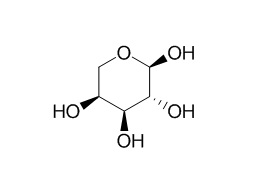D-Arabinose
Biosynthesis of D-arabinose in mycobacteria - a novel bacterial pathway with implications for antimycobacterial therapy.
Inquire / Order:
manager@chemfaces.com
Technical Inquiries:
service@chemfaces.com
Tel:
+86-27-84237783
Fax:
+86-27-84254680
Address:
1 Building, No. 83, CheCheng Rd., Wuhan Economic and Technological Development Zone, Wuhan, Hubei 430056, PRC
Providing storage is as stated on the product vial and the vial is kept tightly sealed, the product can be stored for up to
24 months(2-8C).
Wherever possible, you should prepare and use solutions on the same day. However, if you need to make up stock solutions in advance, we recommend that you store the solution as aliquots in tightly sealed vials at -20C. Generally, these will be useable for up to two weeks. Before use, and prior to opening the vial we recommend that you allow your product to equilibrate to room temperature for at least 1 hour.
Need more advice on solubility, usage and handling? Please email to: service@chemfaces.com
The packaging of the product may have turned upside down during transportation, resulting in the natural compounds adhering to the neck or cap of the vial. take the vial out of its packaging and gently shake to let the compounds fall to the bottom of the vial. for liquid products, centrifuge at 200-500 RPM to gather the liquid at the bottom of the vial. try to avoid loss or contamination during handling.
Int J Mol Sci.2023, 25(1):162.
Int J Mol Sci.2023, 24(18):14077.
Chemistry of Natural Compounds2018, 54(3):572-576
Pharmaceutics.2021, 13(2):187.
Phytochem Anal.2024, pca.3319.
GENENCELL2023, 25:4356740
Evid Based Complement Alternat Med.2022, 2022:1307173.
Tissue Cell.2024, 88:102401.
J Ethnopharmacol.2024, 320:117426.
Journal of Cluster Science2024, 35:635-656.
Related and Featured Products
FEBS J. 2008 Jun;275(11):2691-711.
Biosynthesis of D-arabinose in mycobacteria - a novel bacterial pathway with implications for antimycobacterial therapy.[Pubmed:
18422659 ]
METHODS AND RESULTS:
Decaprenyl-phospho-arabinose (beta-D-arabinofuranosyl-1-O-monophosphodecaprenol), the only known donor of D-Arabinose in bacteria, and its precursor, decaprenyl-phospho-ribose (beta-D-ribofuranosyl-1-O-monophosphodecaprenol), were first described in 1992. En route to D-arabinofuranose, the decaprenyl-phospho-ribose 2'-epimerase converts decaprenyl-phospho-ribose to decaprenyl-phospho-arabinose, which is a substrate for arabinosyltransferases in the synthesis of the cell-wall arabinogalactan and lipoarabinomannan polysaccharides of mycobacteria. The first step of the proposed decaprenyl-phospho-arabinose biosynthesis pathway in Mycobacterium tuberculosis and related actinobacteria is the formation of D-ribose 5-phosphate from sedoheptulose 7-phosphate, catalysed by the Rv1449 transketolase, and/or the isomerization of d-ribulose 5-phosphate, catalysed by the Rv2465 d-ribose 5-phosphate isomerase. d-Ribose 5-phosphate is a substrate for the Rv1017 phosphoribosyl pyrophosphate synthetase which forms 5-phosphoribosyl 1-pyrophosphate (PRPP). The activated 5-phosphoribofuranosyl residue of PRPP is transferred by the Rv3806 5-phosphoribosyltransferase to decaprenyl phosphate, thus forming 5'-phosphoribosyl-monophospho-decaprenol. The dephosphorylation of 5'-phosphoribosyl-monophospho-decaprenol to decaprenyl-phospho-ribose by the putative Rv3807 phospholipid phosphatase is the committed step of the pathway. A subsequent 2'-epimerization of decaprenyl-phospho-ribose by the heteromeric Rv3790/Rv3791 2'-epimerase leads to the formation of the decaprenyl-phospho-arabinose precursor for the synthesis of the cell-wall arabinans in Actinomycetales. The mycobacterial 2'-epimerase Rv3790 subunit is similar to the fungal D-arabinono-1,4-lactone oxidase, the last enzyme in the biosynthesis of D-erythroascorbic acid, thus pointing to an evolutionary link between the D-arabinofuranose- and L-ascorbic acid-related pathways. Decaprenyl-phospho-arabinose has been a lead compound for the chemical synthesis of substrates for mycobacterial arabinosyltransferases and of new inhibitors and potential antituberculosis drugs. The peculiar (omega,mono-E,octa-Z) configuration of decaprenol has yielded insights into lipid biosynthesis, and has led to the identification of the novel Z-polyprenyl diphosphate synthases of mycobacteria. Mass spectrometric methods were developed for the analysis of anomeric linkages and of dolichol phosphate-related lipids.
CONCLUSIONS:
In the field of immunology, the renaissance in mycobacterial polyisoprenoid research has led to the identification of mimetic mannosyl-beta-1-phosphomycoketides of pathogenic mycobacteria as potent lipid antigens presented by CD1c proteins to human T cells.



